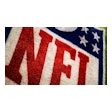It's a well-recognized fact that football helmets cannot prevent concussion, though they do protect the head from blunt-force impacts that can lead to skull fractures and injuries. As growing research suggests that the cause of concussions is not the force of impact but the movement of the head, particularly brain and skull rotation, researchers are also directing their attention to how well helmets are able to protect against these types of injuries.
David Camarillo, an assistant professor of bioengineering and mechanical engineering at Stanford, and his students have been working for several years trying to identify the skull motions that cause concussions, and their research suggests that current helmet-testing techniques and equipment don’t typically account for these types of injury-causing elements.
FROM AB: Helmets at the Center of Battle to Tame Concussions
Camarillo compares the brain to Jell-O in a bowl. When you push a bowl of Jell-O, it takes some time for the dessert to react, but once it does, it overshoots its limits and starts wiggling back and forth. If the same thing were to happen in the skull, this would be a period of brain movement when an injury could occur. This would be an example of the brain accelerating.
It is also important to consider the timing of deceleration, says Camarillo. If the bowl of Jell-O moves forward when the Jell-O is moving backwards, the Jell-O would deform even more.
“The same is true for the brain moving within the skull,” said Camarillo. "It's possible that injury happens when the head whips back and accelerates the brain in one direction right as the brain is starting to go in the opposite direction."
Camarillo and his team first wanted to determine what degree of oscillation is dangerous. By putting pre-existing MRI data into a computer model of the brain, they found the brain’s relative motion is greater when the head oscillates at 15-20 Hz, completing a single back-and-forth motion in about 50 milliseconds.
They compared this finding to data about impacts they had collected from Stanford football players and found that players frequently experienced head oscillations in the 20 Hz range.
However, standards for helmet testing don’t take these findings into account, which may result in helmets that don’t necessarily perform as well as they could.
Currently, the standard test for helmets used in the NFL or NCAA is called the drop test. This involves dropping a dummy head in a helmet from multiple heights to understand different impact magnitudes.
Fidel Hernandez, a Stanford doctoral candidate in mechanical engineering, compared results from drop tests to Camarillo’s findings and found surprising results. The field impacts produced high rotational velocities, but the drop test didn’t produce these. Additionally, Camarillo’s data showed rotational head motions in the 15-20 Hz range and the drop test generated much faster 100 Hz movements.
Drop testing was unable to reproduce accelerations across the full six-degrees-of-freedom spectrum of directions, which were seen in field impacts and are thought to be an important factor in injuries.
According to Hernandez, "The problem with having a model that doesn't re-create what players actually experience in the field, is that you could optimize a helmet to perform well in the drop test that unintentionally performs poorly in the field. For instance, you could design a helmet to stop linear head motion or high-frequency head vibration, because that shows up in the test, but that might not be what is most dangerous to your brain."
FROM AB: Study Shows Concussion Risk 'Dependent on Helmet'
Camarillo says the new work suggests there’s room for improvement in helmet testing standards. They are testing a new system that takes impact velocities and accelerations in six degrees of freedom into account.
He hopes that his work will ultimately lead to stricter guidelines for these types of tests.
"My opinion is that there should be some government regulation in standardizing helmet tests," Camarillo said. "Hopefully people can use the methods we've described here to show that impact forces are being reproduced sufficiently or realistically compared to what's happening in the field."
































